vue3+TypeScript+vue-router的使用方法
目录
- 简单使用
- 创建项目
- vue-cli创建
- vite创建
- 安装vue-router
- 创建/修改组件
- 修改入口ts
- 启动vue
- 在浏览器中访问
- 文件结构图片
- 综合使用
- 动态参数
- 使用watch监听动态参数
- 使用组合API监听动态参数
- 重定向
- 命名与别名
- 命名路由
- 命名视图
- 别名
- 嵌套路由
- 编程式路由
简单使用
创建项目
vue-cli创建
$npm install -g @vue/cli $vue --version @vue/cli 4.5.15 $vue create my-project
然后的步骤:
- Please pick a preset
选择 Manually select features - Check the features needed for your project
选择上TypeScript,特别注意点空格是选择,点回车是下一步 - Choose a version of Vue.js that you want to start the project with
选择 3.x (Preview) - Use class-style component syntax
直接回车 - Use Babel alongside TypeScript
直接回车 - Pick a linter / formatter config
直接回车 - Use history mode for router?
直接回车 - Pick a linter / formatter config
直接回车 - Pick additional lint features
直接回车 - Where do you prefer placing config for Babel, ESLint, etc.?
直接回车 - Save this as a preset for future projects?
直接回车
文件结构:
my-project +--- babel.config.js +--- package-lock.json +--- package.json +--- public | +--- favicon.ico | +--- index.html +--- README.md +--- src | +--- App.vue | +--- assets | | +--- logo.png | +--- components | | +--- HelloWorld.vue | +--- main.ts | +--- shims-vue.d.ts +--- tsconfig.json +--- node_modules | +--- ...
入口文件为
src/main.ts
vite创建
执行以下命令创建项目
$npm init vite-app <project-name> $cd <project-name> $npm install $npm run dev
文件结构:
project-name +--- index.html +--- package-lock.json +--- package.json +--- public | +--- favicon.ico +--- src | +--- App.vue | +--- assets | | +--- logo.png | +--- components | | +--- HelloWorld.vue | +--- index.css | +--- main.js +--- node_modules | +--- ...
入口文件为
src/main.ts
注意: 由于使用vite方法创建的项目没有vue的声明文件, 所以需要我们自定义, 否则会报错.src/shims-vue.d.ts
/* eslint-disable */
declare module '*.vue' {
import type { DefineComponent } from 'vue'
const component: DefineComponent<{}, {}, any>
export default component
}
安装vue-router
$npm install vue-router@4
至此, package.json如下:
{
"name": "my-project",
"version": "0.1.0",
"private": true,
"scripts": {
"serve": "vue-cli-service serve",
"build": "vue-cli-service build",
"lint": "vue-cli-service lint"
},
"dependencies": {
"core-js": "^3.6.5",
"vue": "^3.0.0",
"vue-router": "^4.0.12"
},
"devDependencies": {
"@typescript-eslint/eslint-plugin": "^4.18.0",
"@typescript-eslint/parser": "^4.18.0",
"@vue/cli-plugin-babel": "~4.5.0",
"@vue/cli-plugin-eslint": "~4.5.0",
"@vue/cli-plugin-typescript": "~4.5.0",
"@vue/cli-service": "~4.5.0",
"@vue/compiler-sfc": "^3.0.0",
"@vue/eslint-config-typescript": "^7.0.0",
"eslint": "^6.7.2",
"eslint-plugin-vue": "^7.0.0",
"typescript": "~4.1.5"
}
}
创建/修改组件
创建src/router/index.ts
import { createRouter, createWebHashHistory } from "vue-router"
import Home from '../components/Home.vue'
import About from '../components/About.vue'
import User from '../components/User.vue'
const routes = [
// router参数详细看下文
{
path: "/home",
name: "home",
component: Home
},
{
path: "/about",
name: "about",
component: About
},
{
path: "/user/:uid", // 动态参数
name: "user",
component: User
}
]
export const router = createRouter({
history: createWebHashHistory(),
routes: routes
})
创建组件: Home.vue About.vue User.vue
src/components/Home.vue
<template>
<div>home组件</div>
</template>
<script lang="ts">
import { defineComponent } from "vue";
export default defineComponent({
name: "Home",
setup() {
return {
// 返回的数据
};
},
});
</script>
src/components/About.vue
<template>
<div>About组件</div>
</template>
<script lang="ts">
import { defineComponent } from "vue";
export default defineComponent({
name: "About",
setup() {
return {
// 返回的数据
};
},
});
</script>
src/components/User.vue
<template>
<div>User组件</div>
</template>
<script lang="ts">
import { defineComponent } from "vue";
export default defineComponent({
name: "User",
setup() {
return {
// 返回的数据
};
},
});
</script>
修改App.vue
<template>
<div>{{ appMessage }}</div>
<!-- router-link会被渲染成a标签 -->
<router-link to="/home">home</router-link>
<router-link to="/about">about</router-link>
<router-link to="/user/lczmx">user</router-link>
<!-- 路由出口 -->
<!-- 路由匹配到的组件将渲染在这里 -->
<router-view></router-view>
</template>
<script lang="ts">
import { defineComponent } from "vue";
export default defineComponent({
name: "App",
setup() {
const appMessage = "App组件";
return {
// 返回的数据
appMessage,
};
},
});
</script>
<style>
/* 添加样式 */
#app {
text-align: center;
margin-top: 50px;
}
a {
margin: 30px;
display: inline-block;
}
</style>
修改入口ts
修改src/main.ts:
import { createApp } from 'vue'
import App from './App.vue'
import './index.css'
import { router } from './router'
// 创建应用 返回对应的实例对象
const app = createApp(App)
// 安装 vue-router 插件
app.use(router)
// 调用mount方法
app.mount('#app')
启动vue
$npm run serve > my-project@0.1.0 serve > vue-cli-service serve INFO Starting development server... 98% after emitting CopyPlugin DONE Compiled successfully in 6387ms 下午4:14:30 App running at: - Local: http://localhost:8080/ - Network: http://192.168.43.12:8080/ Note that the development build is not optimized. To create a production build, run npm run build. No issues found.
在浏览器中访问
根据提示, 访问http://localhost:8080/, 如下图
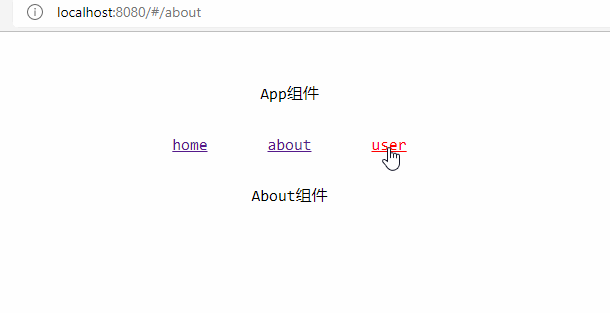
文件结构图片
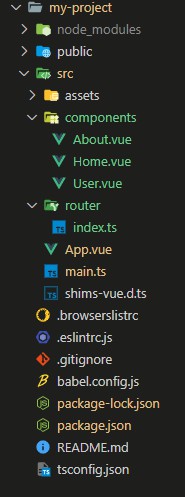
综合使用
动态参数
假如我们需要的路由是: /user/lczmx和/user/jack, 但是我们明显不可能为这两个路由定义两个不同的组件, 最好的方法就是使用动态参数:
const routes = [
// 动态段以冒号开始
{ path: '/users/:id', component: User },
// 使用正则表达式 `()` 里面的东西会传给前面的pathMatch
// 值在route.params.pathMatch下
{ path: '/:pathMatch(.*)*', name: 'NotFound', component: NotFound },
]
匹配时, 会将参数映射到router实例的currentRoute.value.params上
注意vue2中: 由于在
setup无法使用this.$route和this.$router
至于如何获取, 看我的另一篇博客: vue3获取当前路由 和 官网: Vue Router 和 组合式 API
匹配列表
| 匹配模式 | 匹配路径 | 当前路由的参数 |
|---|---|---|
/users/:username |
/users/eduardo |
{ username: 'eduardo' } |
/users/:username/posts/:postId |
/users/eduardo/posts/123 |
{ username: 'eduardo', postId: '123' } |
在使用带有参数的路由时需要注意: 由于相同的组件实例将被重复使用,所以组件的生命周期钩子不会被调用
但是我们可以对路由进行监听
使用watch监听动态参数
修改src/components/User.vue:
<template>
<div>User组件</div>
<p>当前用户: {{ uid }}</p>
<router-link to="/user/lczmx">lczmx</router-link>
<router-link to="/user/jack">jack</router-link>
</template>
<script lang="ts">
import { defineComponent, watch, ref } from "vue";
import { useRouter } from "vue-router";
export default defineComponent({
name: "User",
setup() {
const router = useRouter();
const uid = ref(router.currentRoute.value.params.uid);
watch(
// 监听非响应式数据
() => router.currentRoute.value,
(val) => {
// 修改uid
uid.value = val.params.uid;
}
);
return {
// 返回的数据
uid,
};
},
});
</script>
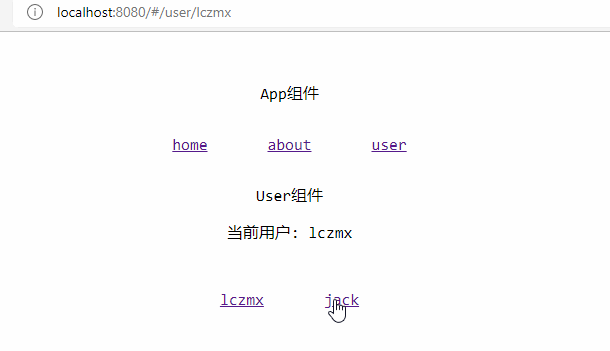
使用组合API监听动态参数
https://next.router.vuejs.org/zh/guide/advanced/composition-api.html
重定向
下面使用router的全部参数:
const routes = [
{
path: "/",
// 写法1 写死url
// redirect: "/home", // 访问 "/" 时 跳转到 "/home"
// 写法2 跳转到对应的命名路由
redirect: { name: "home" },
// 写法3 定义一个方法
// 该方法亦可以 返回一个相对路径
/*
redirect: to => {
// 方法接收目标路由作为参数 "to"
// return 重定向的字符串路径/路径对象
// query指定参数
return { path: '/home', query: { q: to.params.searchText } }
},
*/
},
{
path: "/home",
name: "home",
component: Home
}
]
注意, 重定向不会触发 导航守卫
另附官网的例子: Named Views - Vue Router 4 examples
命名与别名
命名路由
给路由一个名称, 可以在其他路由中使用, 如:
redirect和router-link
const routes = [
{
path: '/user/:username',
name: 'user',
component: User
}
]
在redirect的使用如上文, 而router-link如下:
<template>
<div>User组件</div>
<p>当前用户: {{ uid }}</p>
<router-link :to="{ name: 'user', params: { uid: 'lczmx' } }"
>lczmx</router-link
>
<router-link :to="{ name: 'user', params: { uid: 'jack' } }"
>jack</router-link
>
</template>
在router.push(router是router对象)中使用:
router.push({ name: 'user', params: { uid: 'lczmx' } })
命名视图
即, 我们可以
router-view定义一个名字, 已达到实现可复用的效果
我们可以使用这个功能实现 一个侧边栏等
举个例子
定义路由:
import { createRouter, createWebHashHistory } from "vue-router"
import Home from '../components/Home.vue'
import About from '../components/About.vue'
import User from '../components/User.vue'
const routes = [
{
path: "/",
components: {
default: Home, // 默认用Home组件
a: About, // a用About组件
b: User, // b用User组件
},
},
{
path: "/home",
components: {
default: About, // 默认用About组件
a: Home, // a用Home组件
b: User, // b用User组件
},
},
]
export const router = createRouter({
history: createWebHashHistory(),
routes: routes
})
修改App.vue
<template>
<div>{{ appMessage }}</div>
<!-- router-link会被渲染成a标签 -->
<router-link to="/">/</router-link>
<router-link to="/home">/home</router-link>
<!-- 路由出口 -->
<!-- 路由匹配到的组件将渲染在这里 -->
<!-- default -->
<router-view></router-view>
<router-view name="about"></router-view>
<router-view name="user"></router-view>
</template>
<script lang="ts">
import { defineComponent } from "vue";
export default defineComponent({
name: "App",
setup() {
const appMessage = "App组件";
return {
// 返回的数据
appMessage,
};
},
});
</script>
<style>
/* 添加样式 */
#app {
text-align: center;
margin-top: 50px;
}
a {
margin: 30px;
display: inline-block;
}
</style>
其他组件About.vue:
<template> <div>about组件</div> </template>
Home.vue:
<template> <div>home组件</div> </template>
User.vue
<template> <div>user组件</div> </template>
启动服务并访问vue
如图:
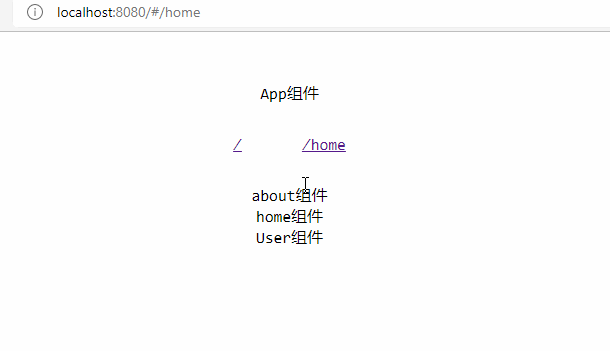
假如不指定视图名, 那么为
default
别名
可以实现 不同url 访问同一路由的效果
const routes = [
// 可以访问 "/home" 也可以访问 "/"
// 且访问的路径不会改变
{
path: "/home",
name: "home",
component: Home,
alias: "/"
}
嵌套路由
之前我们在App.vue中定义router-view, 让其他组件在哪里渲染
但假如我们需要在其他组件中渲染的话, 就需要嵌套路由了
使用
children嵌套路由, 它的值是路由数据, 就好像外部的router那样定义
例子:
router.index.ts
import { createRouter, createWebHashHistory } from "vue-router"
import Home from '../components/Home.vue'
import About from '../components/About.vue'
import User from '../components/User.vue'
import UserHome from '../components/UserHome.vue'
import UserSettings from '../components/UserSettings.vue'
import UserProfile from '../components/UserProfile.vue'
const routes = [
// 可以访问 "/home" 也可以访问 "/"
// 且访问的路径不会改变
{
path: "/home",
name: "home",
component: Home,
alias: "/"
},
{
path: "/about",
name: "about",
component: About
},
{
path: "/user/:uid", // 动态参数
name: "user",
component: User, // 内部有router-view渲染要嵌套的路由
children: [
// 匹配形如 /user/lczmx 的url
{ path: "", component: UserHome },
// 匹配形如 /user/lczmx/settings 的url
{ path: "settings", component: UserSettings, name: "user-settings" },
// 匹配形如 /user/lczmx/profile 的url
{ path: "profile", component: UserProfile, name: "user-profile" }
]
}
]
export const router = createRouter({
history: createWebHashHistory(),
routes: routes
})
注意: 假如
children中没有path: ""的话, 那么访问/user/lczmx, 只能得到一个页面空白
User.vue
<template>
<div>
<router-link :to="{ name: 'user-settings' }">settings</router-link>
<router-link :to="{ name: 'user-profile' }">profile</router-link>
</div>
<router-view></router-view>
</template>
UserHome.vue
<template> <div>用户主页</div> </template>
UserProfile.vue
<template> <div>用户详细信息页面</div> </template>
UserSettings.vue
<template> <div>用户设置页面</div> </template>
启动并访问
在浏览器中测试:
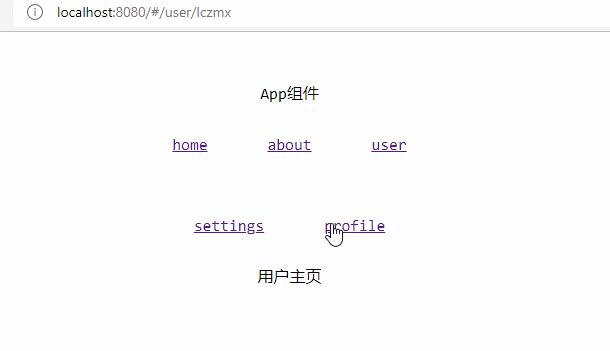
编程式路由
即不通过a标签, 而是通过js/ts改变路由, 原理是向history栈添加一个新的记录
在vue3中, 有以下写法
<template>
<div>about组件</div>
<button @click="changeRouter">修改路由</button>
</template>
<script lang="ts">
import { defineComponent } from "vue";
import { useRouter } from "vue-router";
export default defineComponent({
name: "About",
setup() {
// 获得router对象
const router = useRouter();
const changeRouter = () => {
/* 修改路由的例子 */
// 1 字符串路径
router.push("/users/lczmx");
// 2 带有路径的对象
router.push({ path: "/users/lczmx" });
// 3 命名的路由,并加上参数,让路由建立 url
router.push({ name: "user", params: { username: "lczmx" } });
// 4 带查询参数,结果是 /register?plan=private
router.push({ path: "/register", query: { plan: "private" } });
// 5 带 hash,结果是 /about#team
router.push({ path: "/about", hash: "#team" });
// 6 我们可以手动建立 url,但我们必须自己处理编码
const username = "lczmx";
router.push(`/user/${username}`); // -> /user/lczmx
// 同样
router.push({ path: `/user/${username}` }); // -> /user/lczmx
// 如果可能的话,使用 `name` 和 `params` 从自动 URL 编码中获益
router.push({ name: "user", params: { username } }); // -> /user/lczmx
// 7 `params` 不能与 `path` 一起使用, 否则 `params` 将会被忽略
router.push({ path: "/user", params: { username } }); // -> /user
// 8 replace为true 不向history 中添加
router.push({ path: "/home", replace: true });
// 等同于
router.replace({ path: "/home" });
// 9 横跨历史
// 向前移动一条记录,与 router.forward() 相同
router.go(1);
// 返回一条记录,与router.back() 相同
router.go(-1);
// 前进 3 条记录
router.go(3);
// 如果没有那么多记录,静默失败
router.go(-100);
router.go(100);
};
return {
// 返回的数据
changeRouter,
};
},
});
</script>
<style>
button {
margin: 30px;
}
</style>
更多见vue-router4官网: Vue Router
以上就是本文的全部内容,希望对大家的学习有所帮助,也希望大家多多支持我们。

